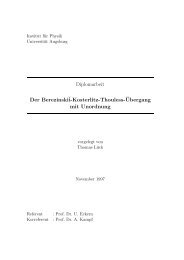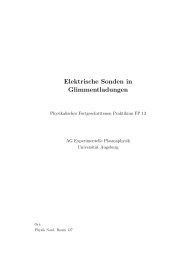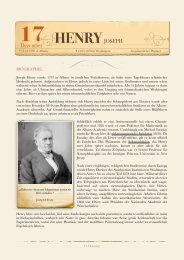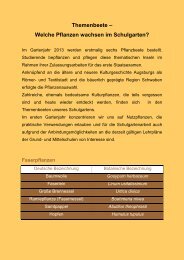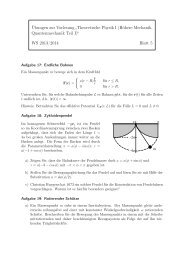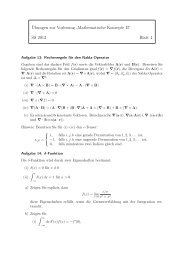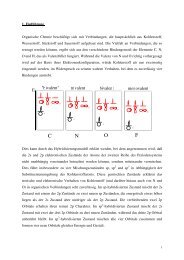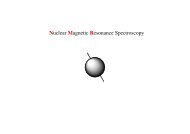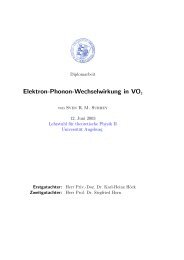PhD Thesis - Universität Augsburg
PhD Thesis - Universität Augsburg
PhD Thesis - Universität Augsburg
You also want an ePaper? Increase the reach of your titles
YUMPU automatically turns print PDFs into web optimized ePapers that Google loves.
12 1. Models<br />
elements t bb′<br />
ij<br />
are expressed as<br />
1 ∑<br />
ij = −δ bb ′ e −i(R j−R i )·k ǫ<br />
L<br />
kb<br />
. (1.17)<br />
t bb′<br />
k∈BZ<br />
Thus, the Hamiltonian (1.2) describing electrons on a lattice reads<br />
H (e)<br />
tot = − ∑<br />
t b ij c† ibσ c jbσ +<br />
∑<br />
i,j,b,σ<br />
i,j,l,m<br />
b,b ′ ,b ′′ ,b<br />
σσ ′ V bb′ b ′′ b ′′′<br />
ijlmσσ ′ c† ibσ c† jb ′ σ<br />
c ′ lb ′′ σ<br />
c ′ mb ′′′ σ<br />
(1.18)<br />
′′′<br />
Unfortunately, even after restricting the problem of a quantum-mechanical description of<br />
a solid to a description of its electronic properties and making all these assumptions and<br />
approximations, the obtained Hamiltonian describes a many-particle problem that is still<br />
technically not tractable in most cases. Therefore further approximations are needed to<br />
reduce its complexity, which will be described in the following section.<br />
1.2 Hubbard model<br />
It follows from Eq. (1.17) that the position of the bands relative to each other is determined<br />
by the matrix elements t b ii . For bands that lie energetically far away from the Fermi<br />
energy E F<br />
, V bb′ b ′′ b ′′′<br />
ijlmσσ /(E ′ F − tb ii) should be a small parameter, so that the electron-electron<br />
interaction between these bands may be neglected. In case there is only one band b F<br />
near<br />
E F<br />
, it may be justified to omit the band indices and focus only on the band that is closest<br />
to the Fermi energy. This assumption leads to an effective one-band model.<br />
The second approximation is to take into account only the maximum term in the<br />
Coulomb interaction. Since the Coulomb interaction decreases as 1/r with distance r, the<br />
maximum term is the local interaction of two electrons residing in the same orbital. For a<br />
single band, the local Coulomb interaction matrix element (“Hubbard U”) reads<br />
∫<br />
U = 2V b Fb F b F b F<br />
iiii↑↓<br />
= e 2 d 3 r d 3 r ′ |ψ i↑b F<br />
(r)| 2 |ψ i↓bF (r ′ )| 2<br />
. (1.19)<br />
|r − r ′ |<br />
The omission of all other contributions of the electron-electron interaction is motivated<br />
by strong screening of the electron-electron interaction, so that the effective interaction<br />
between the electrons is not really long-range and decays stronger than 1/r. This is justified<br />
if the band at the Fermi energy is only partially filled, i.e., if the Fermi energy lies in the<br />
band, as it is the case for metals. However, since the Hubbard model [115, 116, 117,<br />
118] is the conceptually simplest model incorporating the full many-body electron-electron<br />
interaction, from a pragmatic point of view it is justified to use it also to study insulating<br />
systems, if one does not expect a fundamental change of the physics by incorporating



